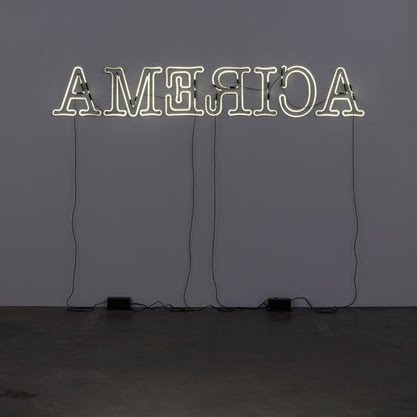 Glenn Ligon: Rückenfigur, 2009. (Neon and paint, 24 × 145 inches) from Ligon's solo show of the same name at the Whitney through June 5th. Holland Cotter's review in this morning's New York Times was scintillating. Here's an excerpt:
Glenn Ligon: Rückenfigur, 2009. (Neon and paint, 24 × 145 inches) from Ligon's solo show of the same name at the Whitney through June 5th. Holland Cotter's review in this morning's New York Times was scintillating. Here's an excerpt:The shift back and forth between reading and looking, object and idea, is the basic dynamic emphasized by the show.... And it represents an effort, very much of the current, formalist, post-'90s moment, to position Mr. Ligon as being as much a craft-conscious painter as a social commentator.Cotter later connects Ligon's use of stencils to Jasper Johns, and it strikes me that these paintings also have something in common with Richard Prince's typographical paintings of a jokes — this one for example — which evoke a certain era and archetype of American male. I'm not a knowledgeable critic, it's just a thought, but it seems like Ligon's repeated words could be read as a response or added perspective to the America of Richard Prince and Jasper Johns (his distressed flags as much as his stencils); I'd like to see paintings by all three side by side. More Cotter:
...
In several paintings beginning in 1990 Mr. Ligon covered wooden doors or door-shaped canvases with stenciled sentences pulled from different sources: an autobiographical essay by Zora Neale Hurston (“I feel most colored when I am thrown against a sharp white background”); Genet’s play “The Blacks” (“I’m Turning Into a Specter Before Your Very Eyes and I’m Going to Haunt You”); a poem by Jesse Jackson (“I Am Somebody”). In each painting the single line is repeated over and over, continuously, in black letters on a gessoed background, with a few paintings white on white, or ivory on ivory. As the words wind down from the top, the stencil becomes increasingly clogged with pigment so that individual characters turn smudgy, and words grow progressively less legible and the bottom of the painting is a kind of miasma.
The effect is most extreme in pictures that quote from James Baldwin’s 1953 essay “Stranger in the Village,” an account of his stay in a tiny Alpine hamlet where, he claimed, no one had ever seen a person with black skin. His tale of enforced visibility and vulnerability ends with a vision of social transformation, specifically in America: “The world is white no longer, and will never be white again.” But Mr. Ligon makes Baldwin’s words all but unreadably dark, by stenciling them with a mixture of black paint and coal dust that cakes and clots on the canvas surfaces like epidermal growth and gives off a spooky sheen.Head over to nytimes.com to read the rest and watch an audio slideshow with curator Scott Rothkopf; visit whitney.org for more info on the exhibition.
Image credit: Whitney Museum of American Art, New York; purchase with funds from the Paint and Sculpture Committee T.2010.71